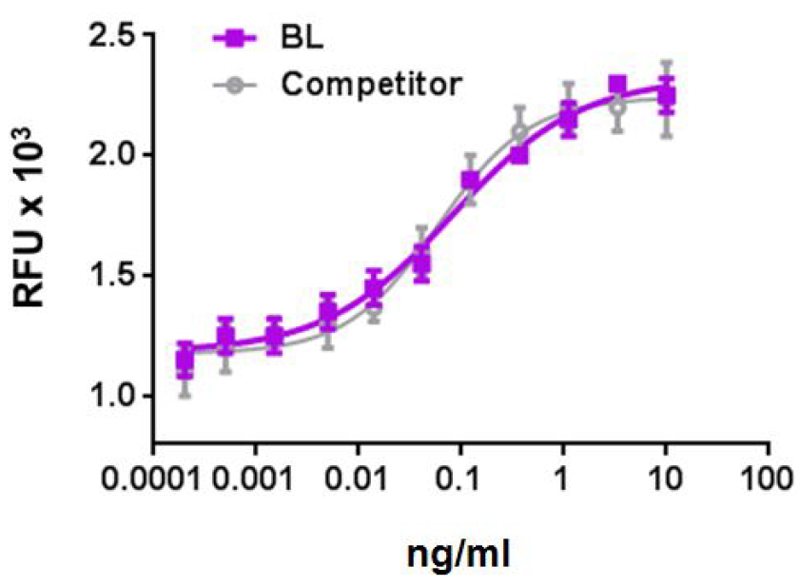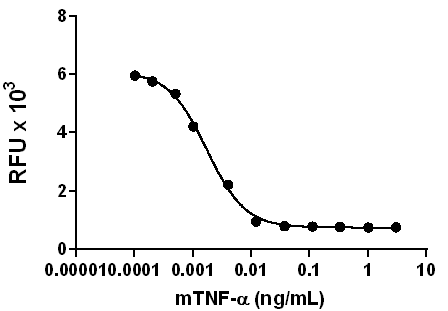- Regulatory Status
- RUO
- Other Names
- IFN-gamma, IFNG2
- Ave. Rating
- Submit a Review
- Product Citations
- publications

-

Recombinant rat IFN-γ induces cytotoxicity in L929 cells in a dose dependent manner. The ED50 of this effect is 0.2 - 1.4 ng/mL
IFN-γ is a key component of the immune response to viral infections. It is produced by NK, NKT, and γ/δ T cells during early stages of infection and by CD4 and CD8 T cells later during the adaptive immune response. During infection, the role of IFN-γ includes protection, clearance, and modulation of the immune response. IFN-γ modulates epithelial cell functions and may play a role in intestinal wound healing as it might help preserve the integrity of the intestinal epithelium. It has been published that IFN-γ enhances IL-27 secretion, and the treatment of rats in a model of arthritis, IFN-γ/IL-27 successfully controlled arthritic inflammation and inhibited mediators of inflammation, angiogenesis, cell survival, apoptosis, and tissue damage. Nevertheless, IFN-γ has been associated with multiple inflammatory and autoimmune diseases such as arthritis, lupus nephritis, diabetic retinopathy, lung fibrosis, allergic conjunctivitis, and pediatric SLE. Rat IFN-γ protein has 39% homology with humans and 85% homology with mice proteins. Due to the high homology between rat and mouse IFN-γ, there is a strong affinity for rat IFN-γ on mouse cells.
Product DetailsProduct Details
- Source
- Rat IFN-γ, amino acids Met-(Gln23-Cys156) (Accession# NM_138880) was expressed in E. coli.
- Molecular Mass
- The 135 amino acid recombinant protein has a predicted molecular mass of approximately 15.6 kD. The DTT-reduced and non-reduced protein migrate at approximately 14 kD by SDS-PAGE. The N-terminal amino acid is Met.
- Purity
- >95%, as determined by Coomassie stained SDS-PAGE.
- Formulation
- 0.22 µm filtered protein solution is in 20 mM HEPES, 150 mM NaCl, 5 mM TCEP, pH 7.2.
- Endotoxin Level
- Less than 0.01 ng per µg cytokine as determined by the LAL method.
- Concentration
- 10 and 25 µg sizes are bottled at 200 µg/mL. 100 µg size and larger sizes are lot-specific and bottled at the concentration indicated on the vial. To obtain lot-specific concentration and expiration, please enter the lot number in our Certificate of Analysis online tool.
- Storage & Handling
- Unopened vial can be stored between 2°C and 8°C for up to 2 weeks, at -20°C for up to six months, or at -70°C or colder until the expiration date. For maximum results, quick spin vial prior to opening. The protein can be aliquoted and stored at -20°C or colder. Stock solutions can also be prepared at 50 - 100 µg/mL in appropriate sterile buffer, carrier protein such as 0.2 - 1% BSA or HSA can be added when preparing the stock solution. Aliquots can be stored between 2°C and 8°C for up to one week and stored at -20°C or colder for up to 3 months. Avoid repeated freeze/thaw cycles.
- Activity
- Recombinant rat IFN-γ induces cytotoxicity in L929 cells in a dose dependent manner. The ED50 of this effect is 0.2 - 1.4 ng/mL
- Application
-
Bioassay
- Application Notes
-
BioLegend carrier-free recombinant proteins provided in liquid format are shipped on blue-ice. Our comparison testing data indicates that when handled and stored as recommended, the liquid format has equal or better stability and shelf-life compared to commercially available lyophilized proteins after reconstitution. Our liquid proteins are verified in-house to maintain activity after shipping on blue ice and are backed by our 100% satisfaction guarantee. If you have any concerns, contact us at tech@biolegend.com.
- Product Citations
-
Antigen Details
- Distribution
-
NK and NKT cells, gamma/delta T cells, CD4, CD8 T cells.
- Function
- IFN-γ has antiviral, antiproliferative, and immunomodulatory properties. IFN-γ, in conjunction with IL-12 and T-bet transcription factor, is essential in TH1 cell differentiation. IFN-γ is synergistically induced by IL-21 and IL-15 or IL-18 in NK T cells. Also, IFN-γ is synergistically induced by IL-12 and IL-18 in T and NK cells.
- Interaction
- T cells, B cells, macrophages, NK cells, endothelial cells, fibroblasts.
- Ligand/Receptor
- Homodimer form by IFNGR1 and IFNGR2.
- Bioactivity
- Antiviral activity on L929 cells using EMC virus.
- Cell Type
- Embryonic Stem Cells
- Biology Area
- Cell Biology, Immunology, Innate Immunity, Neuroinflammation, Neuroscience, Stem Cells
- Molecular Family
- Cytokines/Chemokines
- Antigen References
-
1. Dijkema R, et al. 1985. EMBO 4:761.
2. Wang T, et al. 2003. J. Immunol. 171:2524.
3. Strengell M, et al. 2003. J. Immunol. 170:5464.
4. Rajaiah R, et al. 2011. J. Biol. Chem. 286:2817.
5. Rana A, et al. 2012. Lupus 21:1105.
6. Lee EY, et al. 2013. PLoS One 8:e76412. - Gene ID
- 25712 View all products for this Gene ID
- UniProt
- View information about IFN-gamma on UniProt.org
Related FAQs
- Why choose BioLegend recombinant proteins?
-
• Each lot of product is quality-tested for bioactivity as indicated on the data sheet.
• Greater than 95% Purity or higher, tested on every lot of product.
• 100% Satisfaction Guarantee for quality performance, stability, and consistency.
• Ready-to-use liquid format saves time and reduces challenges associated with reconstitution.
• Bulk and customization available. Contact us.
• Learn more about our Recombinant Proteins. - How does the activity of your recombinant proteins compare to competitors?
-
We quality control each and every lot of recombinant protein. Not only do we check its bioactivity, but we also compare it against other commercially available recombinant proteins. We make sure each recombinant protein’s activity is at least as good as or better than the competition’s. In order to provide you with the best possible product, we ensure that our testing process is rigorous and thorough. If you’re curious and eager to make the switch to BioLegend recombinants, contact your sales representative today!
- What is the specific activity or ED50 of my recombinant protein?
-
The specific activity range of the protein is indicated on the product datasheets. Because the exact activity values on a per unit basis can largely fluctuate depending on a number of factors, including the nature of the assay, cell density, age of cells/passage number, culture media used, and end user technique, the specific activity is best defined as a range and we guarantee the specific activity of all our lots will be within the range indicated on the datasheet. Please note this only applies to recombinants labeled for use in bioassays. ELISA standard recombinant proteins are not recommended for bioassay usage as they are not tested for these applications.
- Have your recombinants been tested for stability?
-
Our testing shows that the recombinant proteins are able to withstand room temperature for a week without losing activity. In addition the recombinant proteins were also found to withstand four cycles of freeze and thaw without losing activity.
- Does specific activity of a recombinant protein vary between lots?
-
Specific activity will vary for each lot and for the type of experiment that is done to validate it, but all passed lots will have activity within the established ED50 range for the product and we guarantee that our products will have lot-to-lot consistency. Please conduct an experiment-specific validation to find the optimal ED50 for your system.
- How do you convert activity as an ED50 in ng/ml to a specific activity in Units/mg?
-
Use formula Specific activity (Units/mg) = 10^6/ ED50 (ng/mL)
 Login/Register
Login/Register 














Follow Us